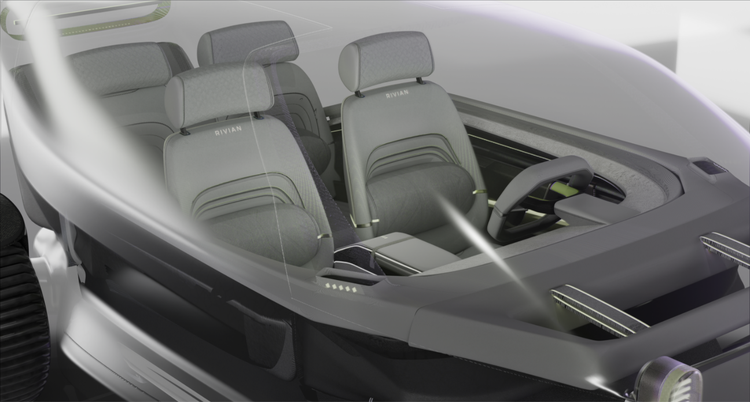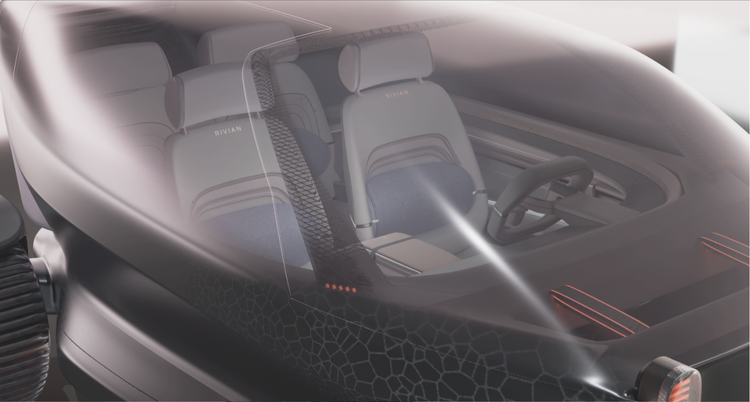Substance 3D education: Transportation design workshop with ArtCenter and Rivian

What happens when you bring together emerging designers, groundbreaking technology, and a real-world challenge from an electric vehicle pioneer? You get an unforgettable, hands-on workshop that pushes the boundaries of creativity and gives students a real taste of the future they’re building.
That’s exactly what unfolded when Adobe teamed up with ArtCenter College of Design and Rivian to launch a transportation design workshop like no other.
Real brief. Real tools. Real stakes.
Students tackled a brief straight from Rivian’s design studio, bringing their concepts to life using the same tools professionals use, like Adobe Substance 3D. This wasn't just about building sleek vehicle forms, it was about telling stories through materials, texture, and motion.
Grouped into small interdisciplinary teams, students from transportation, product, and interactive design worked like an actual automotive studio. The result? Cohesive, innovative visions of the future of mobility.
“Leaning into so many different disciplines really changed my outlook on design,” said transportation student Cosmo Hebert.
His reflection was echoed by Rivian senior manager Julliana Cho, who helped guide the project: “This was Rivian’s first university collaboration. We specifically asked the students to mix disciplines and create a cohesive story. I was genuinely impressed by how well they merged their skills into unified concepts.”




From physical to digital with Substance 3D
Students got hands-on with the Adobe Substance 3D Collection learning how to visualize materials in 3D with incredible realism. Substance 3D Painter felt familiar to many thanks to its Photoshop-like interface, while tools like Sampler and Stager elevated their workflows from sketch to final render.
“Painter feels just like Photoshop,” shared Huilin Zhu, a CMF & Product Design student. “It’s just so easy and flexible... adjusting the layers, but in 3D.” The tools supported a digital-first workflow that emphasized material accuracy and visual storytelling.
Jonathan Szczupak, Rivian’s senior director of Exterior Design, added: “Seeing the way the students used Substance 3D, I was really impressed by the results.”

And with the introduction of the HP Z Captis material scanner, students could capture the physical world and translate it seamlessly into their digital projects. Captis is a portable, AI-enabled device developed by HP in collaboration with Adobe, designed to digitize real-world materials into high-resolution, photorealistic 3D assets.
For many, this was their first time working with scanned materials, and they went all in. “It was a really direct process, from scan to Substance 3D,” explained student Huilin Zhu. “You just import, build on top, or use the scanned material directly.”
“This might be the first time many students have scanned materials,” noted Advisor & Adjunct Instructor at ArtCenter, Safir Bellali, “but they approached it in bold and ambitious ways. It’s something they’ll carry with them into their future careers.”



CMF at the Core: Exploring Color, Material, and Finish
Beyond bold shapes and striking silhouettes, this workshop gave students the chance to dive deep into one of the most important areas of automotive design: Color, Material, and Finish (CMF). With the Adobe Substance 3D tools, they explored how materials can shape emotion, identity, and storytelling in a vehicle.
For students like Huilin who specialize in CMF, that meant building textures from scratch and pushing beyond the expected. “Substance 3D Designer lets me build a material from scratch. The randomness in the node system creates surprising results,” she said.
Using tools like Sampler and Painter, students played with variations in translucency, gloss, pattern, and layering. Scanned materials from HP Z Captis gave them an even richer base to build on.
The result? Students could show multiple material directions and surface options, just like they would in a real studio review.



Mentorship that mattered
Throughout the three-month workshop, students didn’t just get feedback, they were mentored by seasoned professionals from Rivian and Adobe. Weekly reviews, technical sessions, and creative critiques gave them insights that can’t be Googled.
“When I was a student, it was extremely helpful to get feedback from designers working in the industry.” said Cho. “Our job was to guide the students and give them a clearer understanding of what the actual industry is.”
“What made this project exceptional,” said Professor Jae S. Min, “was having Adobe involved as an active contributor. Students were learning tools used in the industry right now.”
This unique access to industry experts allowed students to deepen both their design thinking and technical fluency with advanced tools used across automotive and product visualization today.
"Normally a brand would send 1 or 2 designers, but Rivian sent dozens… so students had such rich feedback from exterior, interior, and CMF experts", said Nicholas Sharma, Senior 3D Artist at Adobe.

Mid-term feedback session at the Rivian studio.
Looking forward
By the end of the workshop, what started as ideas became stunning, studio-quality visualizations. Students walked away with more than a portfolio piece, they gained confidence, technical fluency, and a new appreciation for collaboration.
“Substance lets students reach realism we couldn’t dream of before,” said Min. “What was once a napkin sketch is now a high-fidelity digital material.”
“With all the tools that are accessible today, students can express themselves across such a large scope... it made me wish I was a student again”, Bellali added.

Students during their final presentation.
The experience didn’t just prepare students for careers in design studios, it pushed them to lead the next wave of digital creativity: "Working with ArtCenter was super important”, said Pierre Maheut, Director of Growth for 3D & Immersive at Adobe. “This school has trained the crème de la crème of car designers for generations. Today’s ArtCenter students represent the next generation of creative talent.”
We’re incredibly grateful to ArtCenter College of Design for hosting this one-of-a-kind workshop, to Rivian for bringing such an inspiring brief, and to all the students who poured their creativity, curiosity, and energy into every step of the journey. Their work with Substance 3D didn’t just show what the tools can do, it showed what’s possible when emerging designers are given the freedom to explore, experiment, and push boundaries together.
Want to explore the Substance 3D tools yourself? Check out our free trials or benefit from free education licenses if you are a student or academic staff. Stay tuned for more in the Substance 3D Education Series!